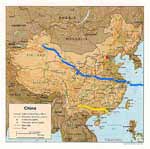1999-2000 (New Year's Eve on the Great Wall),
2000-2001 (from Kunming to Hong Kong by train)
& summer 2001 (from Shanghai to Urumqi by train).
More pictures from China are here
Most of the pictures here were taken between 1999 and 2005. It was in 1999 when we left Canada and came to Japan
to work. From the beginning it was our goal to see the country and move from place to place and whenever possible
travel outside of Japan. The place that caught out attention first was China where we visited for the first time
in December 1999. We went there for 5 days and stayed only in Beijing, but were lucky enough to spend 1999/2000
New Year's party at the Great Wall and be part of a communal celebration by Tibetan community for return of Macau.
Sounds weird, doesn't it?
The trip was short, but interesting enough to bring us there the next winter. This time we had 2 weeks to explore.
We flew to Kunming (Spring City), in Yunnan province, in the mid December and stayed there for 3 days exploring city's neighbourhoods
and temples. The climate and variety of different Chinese minority peoples made Kunming much more interesting than
Beijing. The concentration of many different minorities gave us a chance to see different cultures within one city
from Muslim fast food restaurants that were lit with candles to Hui shishkabobs and dried fruit & nut cake that was
one of the most delicious things we have tried in China.
From Kunming we travelled to Guilin in Guangxi province. We experienced travelling on a Chinese sleeping train
for more than 20 hours. And after arriving in Guilin discovered what money and foreigners actually mean to
Chinese people. The city is just another tourist trap that gets worse and worse year by year. Fortunately, the
scenery that Guilin has to offer can be found throughout the whole province and visiting Guilin sn't necessary.
Next destination was Ghuanzhou city across the border from Macau about 12 hours away by bus. We had a pleasure
to have another new experience - spending a night on a Chinese sleeping bus. After clean sheets, blankets and pillows
on the train, the bus offered complete opposite. It was filthy and smelly. We had no choice, but to use towels us
sheets and then wash them in Macau.
Besides the filth and stinch, smoking was allowed on the bus and 2 guys across the center aisle smoked and talked
throughout the whole night making it impossible to fall asleep. We couldn't open the windows becuse despite warm
temperatures in the day in the south of China during winter, nights were still chilly.
Ghuanzhou was yet another place of new experiences for us. That included being victims of a scum(once only), eating
dog and snake meat and visiting a market where we saw the strangest things that people could call food.
We spent there a day only and by the nightfall we were acros the border in Macau.
Macau is a kind of place that people can fall in love with. How strange when all your senses try to tell you that
you are in Europe and your brain doesn't want to accept that. A little piece of Latin Europe in Asia. Macau was
the place where we celebrated our second New Year in Asia.
The last 2 days of the second trip to China was in Hong Kong that was a total disappoinment after Macau. The only
time this city can be impressive is when visited before and not after Macau. The most impressive was the giant sea
port that is on the way to the international airport.
In summer 2001, we visited China for the third time. After arriving on the eastern coast by a ferry boat
we crossed the country by train from East to West, from Shanghai to Urumqi and back. It included Shanghai,
Xi'an, Lanzhou, Xiahe, Urumqi, and Tulufan. After a few days in crowded, odern, and unimpressive Shanghai,
we found ourselves on a hard seat train designed for the people of the lowest class (in the "classless" society)
It took us to Xi'an, yet another greedy tourist trap. Fortunately, we were out of the city in 2 days and on the way
to the Labrang Monastery, the largest Tibetan monastery outside of Tibet located 3000m above the sea level in a village
that is yet to see its first paved road. Xiahe is where the monastery is located and despite being a small town
without a paved or gravel road, it has a large population of 3 different ethnic groups - Tibetans, Hui and Han.
Next stop - Urumqi, another big, unimpressive Chinese city populated mostly by Han people and....Russians. Perhaps
not living there permanently, there are Rusians and it's hard not to notice that. The number of Russians, Russian stores,
resttaurants, bars and call girls is really visible.
The much more impressive city, not quiet yet, but slowly becoming another tourist trap is Tulufan. This interesting
city located in an oasis in the middle of a desert has a big Uyghur minority, the best in the world watermelons, grapes
and all kinds of raisins. The area around the city offers 2 abandoned, ancient desert cities and many beautiful mosques.
Back to TRAVELS
|

















